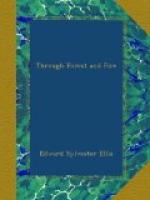“It is a good thing for one, even though he be a child, to be able to do his utmost when overtaken by danger—there can be no question about that; but it would require a great deal of training to bring some children to that point, even when they are double the years of your little girl.”
“Dot’s becos dere folks don’t not begins right; we starts mit Nick and Nellie when dey was so small dot dey didn’t know nuffin, which is why it happens dey knows so much now.”
Great as was the interest excited by the adventure of Nellie, it was not long before it was thrown in the shade by another fact which was brought to light by that same experience: that was the existence of a large bear in the woods which lay to the east and west of the road leading to Dunbarton.
This forest, as has already been intimated, covered a large tract of country, in which, a few years previous, bears, deer, and wolves had been hunted by many of those dwelling on the outskirts. Large inroads had been made on the woodland, and here and there the cabin of a settler or squatter was found by those who penetrated any distance.
There were clearings extending over several acres, while, again, a man might wander for hours without emerging from the timber, which included the common varieties found in the Middle States—oak, beech, maple, birch, hickory, hemlock, black walnut, American poplar or whitewood, gum, elm, persimmon, and others less important.
The pine resembled the famous white pine of the Allegheny mountains, and predominated. Where there was such a large area covered with timber, about every variety of surface was known. In some places were rocks, ravines, hollows, and gulches; in others there were marshy swamps through which a hunter would find it hard work to force his way.
Shark Creek entered from the east and was of considerable volume. In many places it was deep, while elsewhere it widened into broad and shallow expansions. It wound its way through the woods in the sinuous course always taken by such streams, and, crossing the road, where it was spanned by a bridge, it continued onward a quarter of a mile, when it reached Shark Pond, the overflow of which ultimately found its way into the Susquehanna and so to the Atlantic.
Why the waters were called Shark Creek and Pond was more than any one could explain. Most likely it was because no such fish as the shark had ever been seen near them, the circumstances of the case rendering it impossible that such a voracious creature ever should have sported in their depths.
From what has been said, it will be seen that the woods offered a most inviting home for a few wild bears, and there was the best reason for the belief of many of the neighbors that if the tract was well hunted over several of the animals would be found.
The universal opinion was that they should be exterminated, for so long as they were in the woods, so long were they a standing menace to all the men, women, and children who dwelt in the section. The children, especially, were considered in great peril, and several timid mothers refused to let their girls and boys go to school, which stood at no great distance from the woods.




